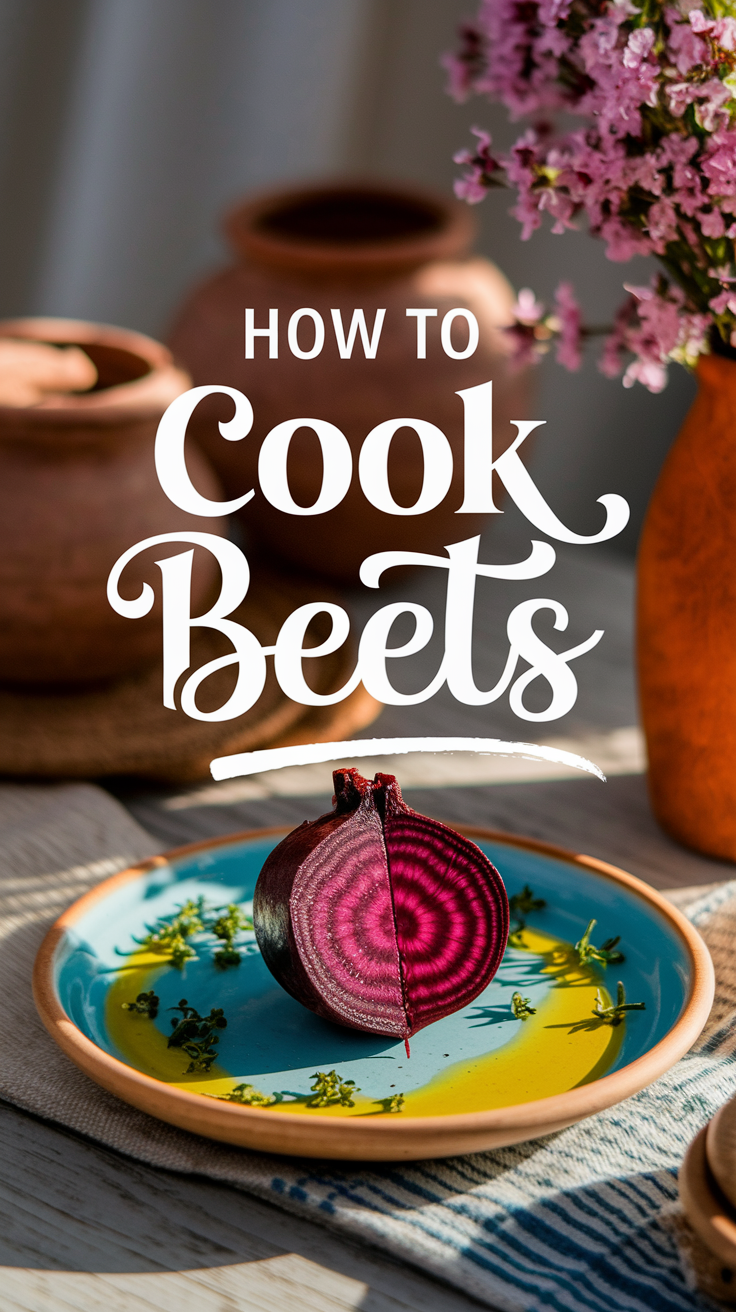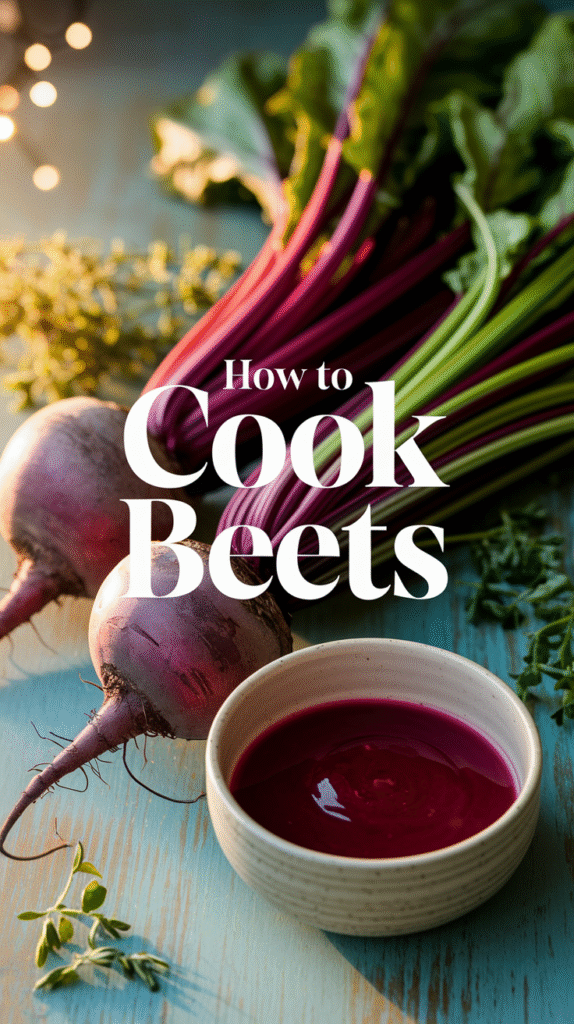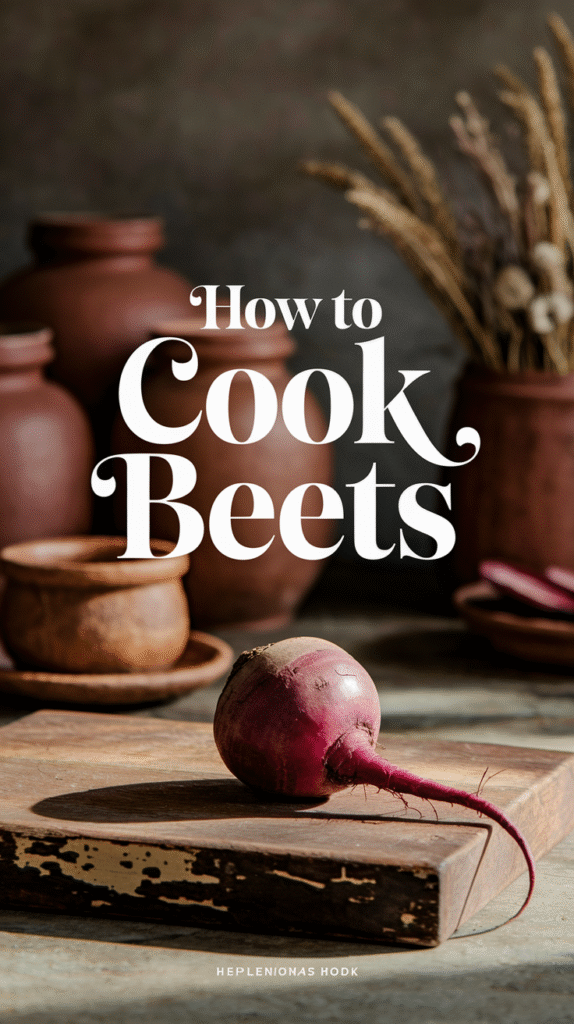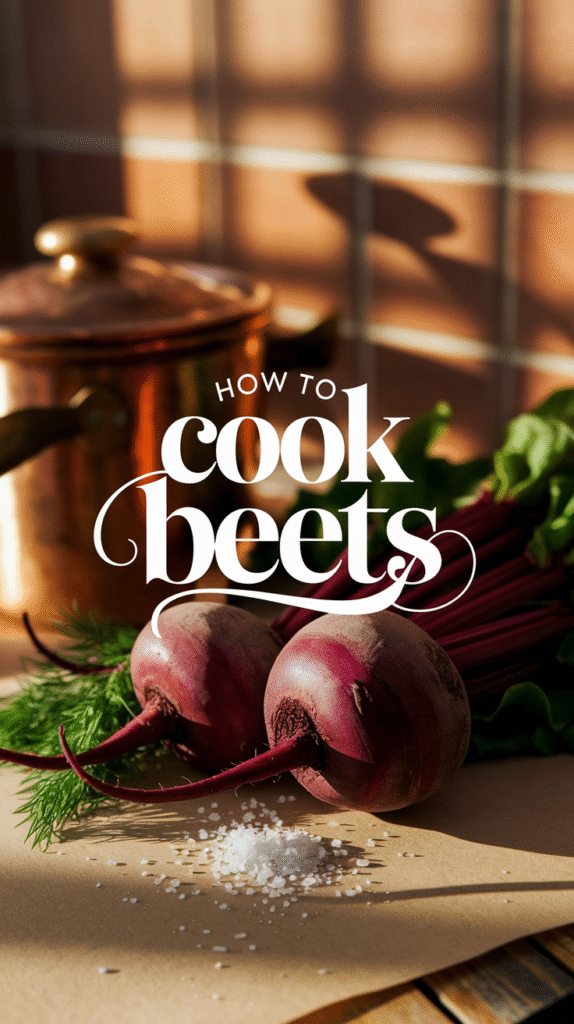Beets are vibrant, nutritious vegetables that can add a delightful sweetness and color to your meals. Learning how to cook beets effectively will allow you to enjoy their earthy flavors while reaping their health benefits, which include high levels of fiber and essential vitamins. Here are several methods for preparing beets that will bring out their best qualities and help you serve delicious dishes.
Boiling Beets
Boiling is one of the simplest ways to cook beets. This method helps to maintain their flavor and nutrition. Here’s how you do it:
- Start by choosing fresh beets. Look for ones that are firm and unblemished.
- Wash the beets well under running water to remove dirt.
- In a large pot, add enough water to cover the beets. Bring the water to a boil.
- Add the beets to the boiling water and reduce the heat to a simmer.
- Cook for 30-45 minutes, depending on the size of the beets. You can test doneness by piercing them with a fork.
- Once done, drain the water and let the beets cool before peeling off the skin.
Stop here to enjoy boiled beets as a side dish, or chop them for salads!
Roasting Beets
Roasting enhances the natural sweetness of beets, giving them a wonderful caramelized flavor. To roast beets, follow these steps:
- Preheat your oven to 400°F (200°C).
- Wash the beets and trim the tops and roots, leaving about an inch of stem on.
- Wrap each beet individually in aluminum foil or place them in a roasting pan with a lid.
- Roast for 45-60 minutes, depending on size, until they are tender when pierced with a fork.
- Allow them to cool before removing the skins.
Roasted beets can be served as is, sliced into salads, or even blended into soups.
Steaming Beets
Steaming beets is another healthy option, as it helps preserve the nutrients. Here’s how:
- After washing the beets, cut off the greens, leaving about an inch of the stem.
- Fill a pot with about an inch of water and place a steaming basket inside it.
- Bring the water to a boil, then add the beets to the steaming basket.
- Cover the pot and steam for 30-40 minutes until fork-tender.
- Remove from heat and allow to cool, then peel.
Steamed beets are perfect in salads or as a healthy snack!
Microwaving Beets
If you’re short on time, microwaving is a quick and easy method to cook beets.
- Wash the beets and place them in a microwave-safe dish with a lid.
- Add a couple of tablespoons of water to the dish.
- Cook on high for about 10-15 minutes, checking for tenderness.
- Let them cool before peeling.
Microwaved beets can be enjoyed sliced or pureed for dips.
Picking Fresh Beets
Before cooking, it’s crucial to choose the best beets. Here are some tips:
- Choose beetroots that are firm and heavy for their size.
- Avoid beets with soft or wrinkled skin.
- Check the greens; they should be vibrant and fresh-looking.
Beets can be stored in a cool, dark place for a few weeks. Once cooked, they can be kept in the refrigerator for about 4-5 days.
For more creative recipes using beets, you can explore [EatingWell](https://www.eatingwell.com/recipe/265087/roasted-beets/) and [Bon Appétit](https://www.bonappetit.com/recipe/roasted-beets-with-balsamic-vinaigrette) which offer a variety of dishes highlighting these colorful vegetables.
By mastering various cooking techniques, you will unlock the full potential of beets, transforming your meals with their unique taste and health benefits. Enjoy experimenting with these methods to create delicious beet dishes that everyone will love!
Nutritional Benefits of Including Beets in Your Diet
When thinking about nutritious food options, beets should be at the top of your list. These vibrant, purple root vegetables are not only tasty but also pack a hefty nutritional punch. Let’s dive into the remarkable health benefits that come from including beets in your diet.
Nutritional Profile of Beets
First, let’s take a look at what makes beets such a powerhouse. Just one cup of cooked beets (about 136 grams) contains:
- Calories: 58
- Carbohydrates: 13 grams
- Fiber: 4 grams
- Protein: 2 grams
- Fat: 0.2 grams
- Vitamin C: 6% of the Daily Value (DV)
- Folate: 20% of the DV
- Potassium: 9% of the DV
Rich in Antioxidants
Beets are loaded with antioxidants, specifically betalains, which give them their distinctive color. These antioxidants help combat oxidative stress in the body, reducing inflammation and lowering the risk of chronic diseases such as heart disease and certain cancers.
Boost Heart Health
The high levels of nitrates in beets can significantly lower blood pressure. When consumed, nitrates convert into nitric oxide, which helps to relax and widen blood vessels, improving overall blood flow. Additionally, studies show that regular consumption of beets can improve cardiovascular health, making them a heart-friendly choice.
Support Digestive Health
Fiber plays an essential role in maintaining digestive health, and beets are an excellent source. Including beets in your diet can help prevent constipation and promote regular bowel movements. A healthy gut contributes to improved overall wellness and can enhance nutrient absorption.
Brain Function and Mental Clarity
The nitrates found in beets aren’t just good for your heart; they can also boost brain function. Studies indicate that increased nitric oxide can enhance blood flow to the brain, which can help improve cognitive function, memory, and overall mental clarity. So, whether you’re studying for an exam or tackling work tasks, consider adding beets to your meals.
Enhance Exercise Performance
For active individuals, beets can be a valuable addition to your workout routine. Research has shown that drinking beet juice can improve stamina and endurance during exercise. The natural nitrates increase efficiency in the mitochondria, which enhances energy production. This means you might find yourself pushing through those last few reps more easily after a serving of beets!
How to Prepare Beets
Beets into your meals can be simple. Here are a few ways to enjoy them:
- Roasted: Cut beets into wedges, toss with olive oil, and roast them at 400°F (200°C) until tender.
- Salads: Shred raw beets into salads for a crunchy texture and bright color.
- Soups: Blend cooked beets into soups for a hearty and nourishing dish.
- Juiced: Juice beets along with other fruits and vegetables for a refreshing drink.
Potential Risks and Considerations
While there are numerous benefits to eating beets, they can also pose certain risks for some individuals. For instance, beets are high in oxalates, which may lead to kidney stone formation in susceptible individuals. It’s best to consult a healthcare professional if you have a history of kidney stones.
Beets into Your Life
Whether you prefer eating them raw, roasted, or in a juice, making beets a part of your diet is both easy and rewarding. A colorful addition to your plates, beets provide essential nutrients that support various aspects of health.
For more information on beets and how to incorporate them into your diet, you can visit Healthline and WebMD.
Creative Ways to Use Cooked Beets in Recipes
Cooked beets are a vibrant and nutritious ingredient that can elevate your meals in creative and delicious ways. Their earthy flavor and mesmerizing color make them a fantastic addition to various dishes. Here are some imaginative ways you can incorporate cooked beets into your cooking.
1. Beet Salad Variations
Transform simple salads with the addition of cooked beets. Their natural sweetness pairs beautifully with various ingredients. Consider these combinations:
- Beet and Goat Cheese Salad: Toss diced cooked beets with arugula, creamy goat cheese, walnuts, and a balsamic vinaigrette for a delightful mix of flavors.
- Citrus Beet Salad: Combine cooked beets with orange segments, red onion, and a light citrus dressing. This refreshing salad is perfect for summer.
- Quinoa and Beet Salad: Mix cooked beets with quinoa, feta cheese, and fresh herbs for a hearty and satisfying dish.
2. Delicious Beet Hummus
Elevate your dips by making beet hummus. This vibrant spread is both visually appealing and delicious. To prepare, blend cooked beets with canned chickpeas, tahini, lemon juice, garlic, and olive oil until smooth. Enjoy it with pita chips or vegetable sticks for a healthy snack.
3. Roasted Beet Tacos
Give your taco night a colorful twist by using roasted beets as the main filling. The sweetness of beets complements savory taco ingredients beautifully. Here’s how:
- Roast diced cooked beets with olive oil, cumin, and chili powder.
- Serve in corn tortillas with avocado, cilantro, and a squeeze of lime.
- Add crumbled feta or cotija cheese for an extra layer of flavor.
4. Creamy Beet Soup
A warm bowl of beet soup is a comforting and nutritious meal. For a creamy beet soup, sauté onions and garlic in a pot, add cooked beets, vegetable broth, and a splash of cream. Blend until smooth, and serve with a dollop of yogurt and fresh herbs.
5. Beet Smoothies
For a nutritious breakfast or snack, add cooked beets to your smoothies. They provide a beautiful color and vitamins without overpowering the flavor. Here’s a simple recipe:
- 1 cup cooked beets
- 1 banana
- 1 cup spinach
- 1 cup almond milk (or any desired milk)
Blend until smooth, and enjoy a healthy, energizing drink!
6. Beet Risotto
Enhance traditional risotto with the addition of cooked beets. The vibrant color adds visual appeal, while the flavor deepens the dish. Follow these steps:
- Cook arborio rice slowly in vegetable broth.
- Add diced cooked beets toward the end of cooking, along with parmesan cheese.
- Garnish with fresh herbs for extra freshness.
7. Colorful Pasta Dishes
Integrate cooked beets into your pasta dishes for a touch of color and nutrition. Mix beet pureé into your pasta sauce for a visually stunning dish, or toss pasta with sautéed beets, garlic, and spinach. Top with parmesan for a delightful dinner.
8. Baking with Beets
Surprisingly, cooked beets can also be used in baked goods. Their natural sweetness allows you to reduce added sugars in recipes. Consider beet brownies or muffins. Replace some of the fat in your recipes with puréed beets – you’ll be rewarded with moist and flavorful treats!
9. Creative Beet Pickles
Beets make a great addition to homemade pickles. To prepare:
- Combine vinegar, water, sugar, and spices in a pot and heat until dissolved.
- Add sliced cooked beets and let them marinate in the solution for at least 24 hours.
- These bright pickles can jazz up sandwiches or salads!
Using these creative ideas will inspire you to make the most of cooked beets, adding flavor, color, and nutrients to your meals. Ready to explore more about the health benefits and recipes featuring beets? Visit Healthline for detailed insights.
Experiment with these dishes and let your culinary creativity shine with the fantastic flavor of cooked beets!
Tips for Selecting and Storing Fresh Beets
Selecting and storing fresh beets require a keen eye and some simple techniques to ensure they retain their flavor and nutritional value. Here are some tips to help you choose the best beets and keep them fresh for longer.
Choosing Fresh Beets
When you’re at the market or grocery store, it’s important to select beets that are both fresh and appealing. Here are some pointers on what to look for:
- Color: Choose beets that are vibrant in color. Deep purple, ruby red, or golden beets indicate freshness.
- Firmness: Fresh beets should feel firm to the touch. Avoid any that are soft or mushy, as these may indicate spoilage.
- Size: Look for medium-sized beets, typically 2 to 3 inches in diameter. Larger beets can be woody and may have a less desirable texture.
- Greens: If the beets still have their greens attached, check the leaves. Fresh greens should be bright green and crisp. Wilted or yellowing leaves suggest the beets are not fresh.
How to Store Fresh Beets
Once you’ve selected your beets, proper storage is key to maintaining their quality. Here’s how to store them effectively:
- Remove the Greens: If your beets have greens, remove them before storage. Greens can draw moisture from the roots, causing them to spoil faster.
- Keep Them Cool: Store beets in the refrigerator’s crisper drawer. The ideal temperature for beets is around 32°F (0°C).
- Moisture Control: To keep beets fresh, place them in a perforated plastic bag to allow moisture to escape while retaining a bit of humidity. This prevents wilting.
- Avoid Washing Before Storage: Don’t wash beets before storing them, as moisture can promote spoilage. Wash them just before cooking or eating.
- Long-Term Storage: If you want to keep beets for an extended period, consider freezing them. Blanch beets in boiling water for about 15 minutes, then cool them quickly in ice water. Once cooled, peel and chop them before freezing in airtight bags.
Tips for Using Stored Beets
When you’re ready to cook your stored beets, keep these tips in mind:
- Before Cooking: Trim the root and the leaves, leaving about an inch of stem. This prevents them from bleeding during cooking.
- Cooking Methods: Beets can be boiled, roasted, steamed, or pickled, offering various flavor profiles and textures. Experiment to find your favorite way to cook them.
Nutritional Benefits
Beets are not just delicious; they are also packed with nutrients. They are a great source of:
| Nutrient | Benefits |
|---|---|
| Fiber | Aids digestion and helps maintain a healthy gut. |
| Folate | Essential for DNA synthesis and repair. |
| Vitamin C | Supports the immune system and skin health. |
| Antioxidants | Help reduce inflammation and combat oxidative stress. |
Fresh beets can enhance not only the taste of your meals but also your overall health. By knowing how to select and store beets properly, you can enjoy these nutritious vegetables for weeks to come.
For more information on selecting and storing beets, you can visit Eat Fresh or Food Network.
Common Mistakes to Avoid When Cooking Beets
Cooking beets can be a delicious endeavor, but many people make common mistakes that can affect the taste, texture, and nutritional value of this vibrant root vegetable. Understanding these missteps can elevate your beet cooking game and ensure you enjoy their full potential. Here are some common pitfalls to avoid when preparing beets.
Neglecting Proper Cleaning
One of the first mistakes is not cleaning beets thoroughly. Beets can be covered in dirt and grit that may transfer to your dishes. Follow these steps to clean them properly:
- Rinse each beet under cold water.
- Scrub gently with a vegetable brush to remove any soil.
- Trim off the tops, leaving about an inch of the stem to prevent bleeding during cooking.
By ensuring your beets are clean, you’ll enhance their taste and presentation.
Overcooking the Beets
Overcooking beets is a frequent mistake that can lead to a mushy texture. Beets should be cooked until they are fork-tender, which typically takes:
| Cooking Method | Time (minutes) |
|---|---|
| Boiling | 30-45 |
| Roasting | 45-60 |
| Steaming | 30-40 |
| Microwaving | 10-15 (whole, with skin) |
Check for doneness by piercing a beet with a fork; it should slide in easily but still hold its shape.
Not Using Enough Seasoning
Beets have a naturally sweet flavor that can be enhanced with proper seasoning. A common mistake is under-seasoning, which can make your dish bland. When cooking beets, consider adding:
- Salt to the cooking water to enhance flavor.
- Herbs like rosemary or thyme for added aroma.
- Acidic elements like vinegar or lemon juice to brighten their taste.
Experimenting with spices can make a significant difference in your beet dishes.
Ignoring Cooking Techniques
The technique used to cook beets matters significantly. Simply boiling them can leach out nutrients. Here are some effective methods:
- Roasting: Drizzle with olive oil and season before wrapping in foil and baking. This enhances the sweet flavor.
- Steaming: This method retains more nutrients and gives the beets a firmer texture.
- Grilling: Grill slices or whole beets for a smoky flavor that pairs wonderfully in salads.
Each method provides a unique taste and texture, so feel free to explore them!
Failing to Peel Properly
Another mistake is peeling the beets before cooking. When you peel before cooking, you lose a significant amount of flavor and nutrients. The skins can protect the beets during cooking and are easier to remove afterward. Simply cook with the skin on and slip it off once they cool.
Skipping Storage Tips
If you prepare beets in advance, improper storage can affect their quality. Store cooked beets in an airtight container in the fridge for up to five days. For raw beets, keep them in the crisper drawer with the tops removed for optimal freshness.
Choosing the Wrong Variety
Beets come in different varieties, including red, golden, and striped. Different varieties have distinct flavors and can affect your dish. For example, golden beets are milder and sweeter than traditional red beets. Selecting the right variety based on your dish and personal preference can enhance your cooking experience.
For beautifully flavorful beets, visit Eating Well which provides further cooking techniques and recipes.
By avoiding these common cooking mistakes, you can enjoy delicious, nutritious beets that will surprise your taste buds and impress your dinner guests. Happy cooking!
Conclusion
Cooking beets can be a rewarding culinary experience that brings not only vibrant color to your plate but also a multitude of nutritional benefits. By exploring various cooking methods such as steaming, roasting, and boiling, you can achieve delicious results that enhance the natural sweetness of these root vegetables. Including beets in your diet is a smart choice, as they are rich in essential vitamins, minerals, and antioxidants that contribute to overall health.
Once cooked, beets are incredibly versatile. You can incorporate them into salads, smoothies, soups, or even create creative dips and spreads. Their unique flavor and texture allow for endless possibilities in the kitchen, making them an exciting addition to any meal.
When selecting fresh beets, look for firm, smooth skins and vibrant leaves, ensuring you’ll get the best quality for your recipes. Proper storage is equally important; keeping them in a cool, dark place will help prolong their freshness.
It’s also essential to be mindful of common mistakes when cooking beets. Overcooking can lead to a mushy texture, while underseasoning may not bring out their full flavor. By avoiding these pitfalls, you can elevate your beet dishes from ordinary to extraordinary.
With these tips and insights, you now have the knowledge to successfully cook beets and enjoy their numerous benefits. Embrace this colorful vegetable in your meals, and watch as it transforms your dishes into something special. Happy cooking!







Leave a Reply